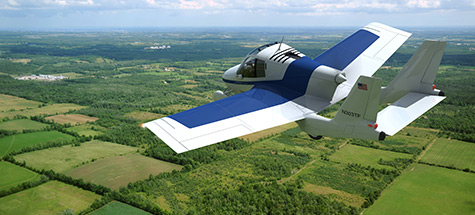Aerocar: Keepers of the car
Why I never wrote about Ed Sweeney’s Aerocar
This story has been one year in the making, or I should say, unmaking. This is actually more of an excuse to my editor for never writing about the late Molton Taylor’s Aerocar in the fall of 2009. I can explain.
The dog didn’t eat my article. That excuse has already been used. Besides, I don’t even have a dog. The real reason is that the Aerocar has been in ill health this past year. When I arrived at the maintenance shop in Auburn, California, where the Aerocar happened to live on September 21, 2009, I had expected to fly it. I was prepared, having reviewed 17 articles on the history of the flying car. Experts were waiting to comment for the article on the future of flying cars.
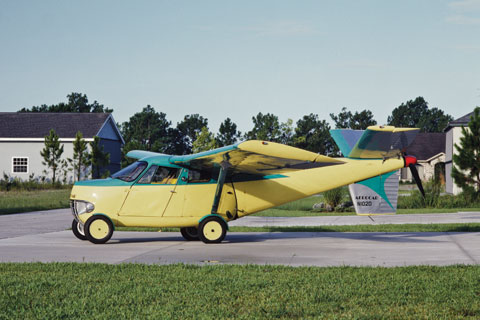
Auburn Aircraft Works is run by aircraft technician Eric Sweeney, son of current Aerocar owner Ed Sweeney. It isn’t the only one in existence, but it’s the only one flying (when it feels up to it). By good fortune, Ed (from Colorado), son Sean (from Florida), and of course Eric.
I have been blessed throughout my life with an excess of calories, and when Eric saw the result of that wealth, he pronounced me too heavy to fly out of ground effect. The Aerocar can’t lift much. I agreed to settle for just wiggling the co-pilot stick a little during a flight just above the runway. Then we decided maybe Sean, with 20 hours in the Aerocar, would fly and I would videotape from the ground. My hopes for the story were now on the ground, just like the aircraft.
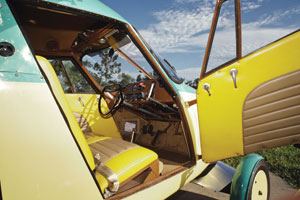 When the trailer was opened, we noticed metal shavings on the floor. Its power shaft to the rear pusher prop had bounced against metal on the way back from an airshow in Reno, filing off metal in the process. But that wasn’t even the main problem.
When the trailer was opened, we noticed metal shavings on the floor. Its power shaft to the rear pusher prop had bounced against metal on the way back from an airshow in Reno, filing off metal in the process. But that wasn’t even the main problem.
After the Aerocar was removed and assembled, by attaching the tail boom and unfolding the wings, Eric found cracks in the tail. (Eric is the guy you want inspecting your airplane.) That was a showstopper, so what now?
I had made videos of the assembly process, interviewed the father and brothers, and taken point-and-shoot pictures for note-taking purposes, never thinking they were going to be used. The video you can see online.
There was still a chance the California-based photographer could photograph it once it was repaired, so I called a few months later with the question, “Is it fixed yet?” No, a new inspection revealed that one of the prop blades had been set for climbing while the other was set for cruising. Eric could only work on it between paying maintenance jobs. In 2010 I called again, and the answer was again no. More cracks in the fuselage.
Minutes before I started writing this, I made a last call as the one-year anniversary of my article preparation approached. Yes, it is fixed, but it was driven to Sean’s residence in Florida where his 16-year-old son hopes to make his first solo in it, and perhaps get his driver’s license the same day—if a driving examiner is found who will accept it as a car. As a car, its engine sounds just like an airplane, especially in quiet suburbia.
The decision was made then to write this article about why I didn’t write an article. It could have been great. For example, you would have heard from Jake Schultz, a technical analyst who works in new airplane development for Boeing and author of A Drive in the Clouds: The Story of the Aerocar.
“Jake,” I would have asked, “when will we have a flying car?”
“If you listen to those who have—or are trying to build flying automobiles—you often get the impression that success is ‘just a few more years away...’ I pose the question, ‘What will we be driving or flying 300 years from now?’”
Boy, that would have been a great answer to use in the article.
“You can make an analogy with the personal watercraft industry,” Schultz would have continued. “There were a large number of ‘build your own water scooter’ designs in Popular Science and Mechanics Illustrated magazines for many, many years. But it was not until the advent of the Kawasaki Jet Ski that the market really exploded. It met enough consumer ‘requirements’ at a price that justified its purchase. Now there is an entire class of personal watercraft and most of them are drastically different than the Jet Ski—the one that launched the category to begin with.
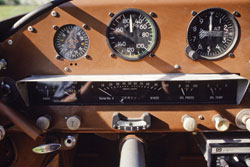 “My prediction is that a similar path will play out with flying automobiles. There have been, and are, many designs of all types, but one will probably come along in the next decade or two which is fairly successful—as far as flying cars go—and that will spur a whole series of similar and evolutionary designs.”
“My prediction is that a similar path will play out with flying automobiles. There have been, and are, many designs of all types, but one will probably come along in the next decade or two which is fairly successful—as far as flying cars go—and that will spur a whole series of similar and evolutionary designs.”
Some readers who share Molt Taylor’s passion for a flying car would have been disappointed in the “300 years” comment by Schultz, so—if I had written the article—I would have countered it with a quote from Palmer Styles of Florida. A former mechanical engineering instructor at the Florida Institute of Technology, he once offered a flying car design of his own, with canards. To become a car, his design would fold the canards inward, and fold the wings over the fuselage. All the parts of the airplane would stay together all the time.
“I’m cautiously optimistic,” Styles would have said. “Terrafugia is working on it, but they have some problems. They have to land it flat and it is hard to rotate for landing or takeoff. I like their approach because they are the first ones to go after the Light Sport aircraft category. That makes it easier for them to develop their machine. I would hope that in the next 10 years, we would see a machine that we could buy. I think the Terrafugia guys have the best chance of coming through with that. Now, they are getting behind schedule.” (See “What’s Up with Terrafugia?” below.)
I could even have told you about the Glenn Curtiss Autoplane of 1917 (patented in 1919, the second flying car patent in the world), the Mizer that linked a Cessna Skymaster to a Ford Pinto (and was shown allegedly flying in a fake advertising movie), and the Waterman Aerobile that was certified in 1957.
But now there is no article, and all that research is wasted. It would have been a great article.
E-mail the author at [email protected].
What’s up with Terrafugia?
A new weight limit, a new production facility
By Jill W. Tallman
The Terrafugia Transition roadable airplane—or flying car, depending on whom you talk to—made a splashy debut at EAA AirVenture 2009 in Oshkosh. The timing couldn’t have been better. Videos showing the proof-of-concept Transition making a short flight at an airport in New York were all over the news and Internet, and visitors to AirVenture swarmed the Terrafugia tent to see it for themselves.
The proof of concept was “very much just what it’s called—a proof of concept—and not a final production model,” said Anna Mracik Dietrich, chief operating officer of Terrafugia Inc. “We wanted to get experience with hardware and testing as quickly as possible, so we used off-the-shelf solutions whenever possible. We set out to answer a basic set of questions with the testing program and succeeded.” The answers “provided valuable insight into flying qualities of an aircraft with a new and somewhat unconventional geometry,” Dietrich said.
Test pilot Phil Meteer said the Transition “flies like a really nice little airplane.”
It’s easy to land, allowing the pilot the choice of a conventional flare or just flying it onto the runway, and it comes off the runway with lots of stall margin, Dietrich added. “Rotation procedure is standard, although the long wheelbase that ensures stability on the road does require that the aircraft be going about 70 knots—instead of just above stall speed—on takeoff.” This takes about 1,700 feet of takeoff roll to achieve.
In June 2010, Terrafugia received an important boost from the FAA. The agency granted an exemption allowing the Transition a maximum takeoff weight of 1,430 pounds. Even with the additional weight, the vehicle remains within the Light Sport aircraft category.
The exemption accommodates extra weight for airbags, an energy-absorbing crumple zone, and a protective safety cage—items needed to comply with U.S. motor vehicle safety standards, the company said. Simulated crash tests have been completed.
At AirVenture 2010, Terrafugia showed computer renderings and new specifications for a production prototype. Design features include a touch-screen interface in the cockpit and an improved wing with an optimized airfoil and a folding mechanism that will allow it to be operated from within the cockpit. You can view computer renderings of the prototype and videos of the proof of concept taking flight at the company website.
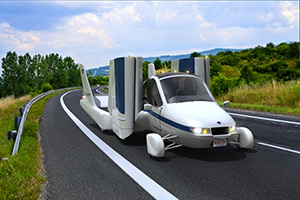 The Transition has been reclassified from passenger car to multipurpose vehicle for the motor vehicle safety standards, Dietrich said. This change allowed the company to remove the canard from the proof of concept. “It was there to meet the full-width bumper requirement of the passenger-car category. Without the canard, the next-generation design has cleaner aerodynamics and a bumper integrated directly into the crash safety structure of the vehicle,” she said.
The Transition has been reclassified from passenger car to multipurpose vehicle for the motor vehicle safety standards, Dietrich said. This change allowed the company to remove the canard from the proof of concept. “It was there to meet the full-width bumper requirement of the passenger-car category. Without the canard, the next-generation design has cleaner aerodynamics and a bumper integrated directly into the crash safety structure of the vehicle,” she said.
Terrafugia is building two prototypes in a 19,000-square-foot production facility in Woburn, Massachusetts, outside of Boston. One will be used for road testing and the other for LSA flight testing, planned to take place in the spring. Low-volume production could begin in late 2011, and a first customer delivery could happen by the end of 2011. At this writing, the price is expected to be between $200,000 and $250,000.
And while the world waits for a flying car, Terrafugia is forging ahead as part of a team chosen by the Defense Advanced Research Projects Agency to develop the Transformer X (TX) for the military. Calling the TX “effectively a flying Humvee,” Dietrich says it is distinct from the Transition project in many ways but nonetheless allows the company to apply expertise learned from its existing development program to new applications.
E-mail the author at [email protected].
